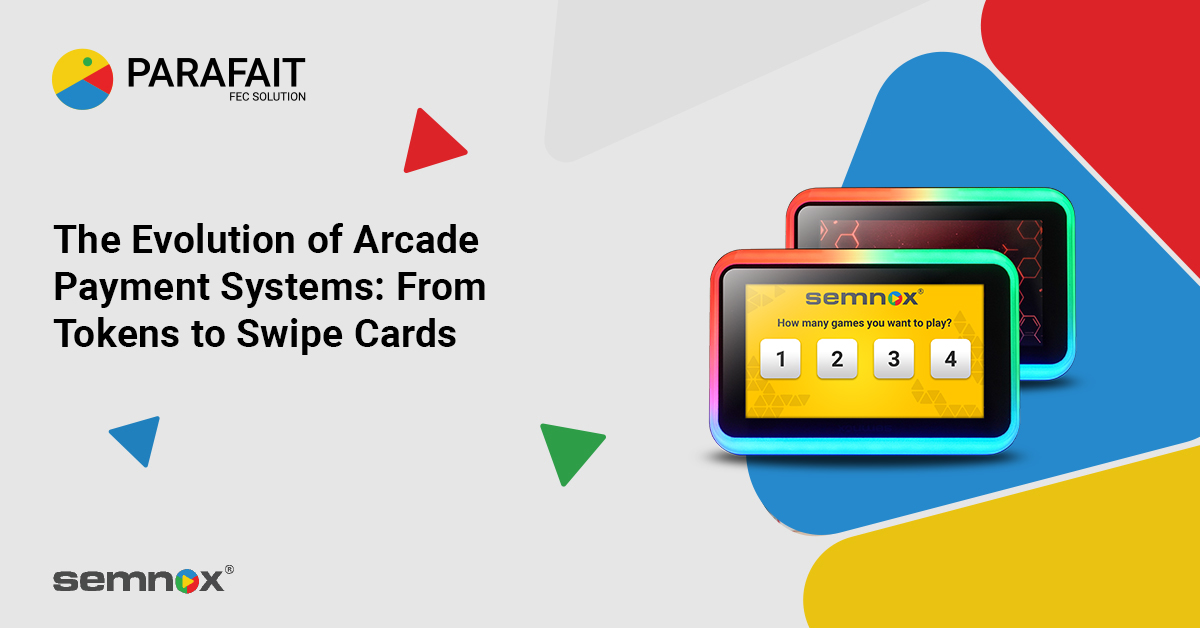
The Evolution of Arcade Payment Systems: From Tokens to Swipe Cards
Table of Contents
Introduction
The landscape of arcade gaming has undergone a significant transformation over the years. From the clinking sound of tokens to the seamless swipe of a card, arcade payment systems have evolved to enhance player experience and streamline operations. While some still consider the method of tokens a nostalgic rite of passage to one’s youthful arcade experience, this blog explores the journey of arcade payment systems, highlighting the shift from traditional tokens to modern arcade swipe card systems and beyond.
The Token Era: Tangibility and Tradition
Tokens were once the lifeblood of arcades, offering a tangible connection between players and their favorite games. Each token represented a moment of anticipation, a physical embodiment of the excitement that awaited. Arcades thrived on this simple, yet effective, payment method, allowing players to immerse themselves in the world of gaming with the satisfying clink of metal.
However, the token era was not without its limitations. Tokens could be lost or stolen, and arcade owners faced challenges in managing and securing large quantities of coins. Despite these drawbacks, tokens remained the standard for many years, symbolizing the traditional arcade experience.
The Shift to Swipe Cards: Convenience and Control
As technology advanced, so too did the need for a more efficient payment system. Enter the arcade swipe card system—a game-changer for both players and arcade operators.
Emergence of Swipe Cards
The introduction of swipe cards revolutionized the arcade industry, offering a convenient alternative to tokens. These cards could store multiple credits, allowing players to enjoy uninterrupted gaming sessions without the need to constantly reload with tokens. This new system also made it easier for arcades to manage payments, track player activity, and reduce the risks associated with handling physical coins.
Benefits of Swipe Cards for Players and Arcade Owners
Swipe cards brought a host of benefits to the table. For players, they offered a streamlined experience, eliminating the need to carry pockets full of tokens. The ability to easily reload credits and track spending added a new level of convenience and control. For arcade owners, swipe cards provided valuable data insights into player behavior, enabling more targeted promotions and loyalty programs. Additionally, the reduced need for coin handling led to lower operational costs and increased security.
The Digital Transition: Contactless and Mobile Payments
As digital technology continued to evolve, so did arcade payment systems. The introduction of contactless and mobile payment options marked the next phase in the evolution of arcade game card swipe systems. Players could now simply tap their card or use a mobile app to make payments, further enhancing convenience and reducing friction at the point of sale.
Parafait Solutions by Semnox, has been at the forefront of this digital transition since 2008. The introduction of RFID tap-to-play arcade game card readers enabled a truly contactless gaming experience. These card readers allow players to quickly tap their card on the game’s reader to start playing, eliminating the need for swiping or inserting cards. This not only enhances the player’s experience but also speeds up transaction times, allowing for more gameplay.
The Future of Arcade Payments: Integration and Personalization
Looking ahead, the future of arcade payment systems lies in further integration and personalization. Parafait’s ongoing innovation ensures that arcade operators can provide their customers with more tailored experiences. From fully integrated mobile apps to account personalization, the arcade experience is set to become more dynamic than ever before.
In addition to RFID readers, Parafait’s suite of solutions includes self-service kiosks that further complement contactless and cashless transactions. Players can easily reload their arcade game cards using these kiosks, which accept various payment methods, including credit cards and mobile wallets. This cashless approach minimizes the need for staff intervention, reduces cash handling risks, and provides players with a seamless way to manage their credits.
As the arcade industry continues to evolve, exploring upgrades to your payment systems is essential for staying competitive. With Semnox Solutions powering your arcade management, you can be confident that your business will keep pace with the latest technological advancements.
Conclusion
As the arcade industry continues to evolve, exploring upgrades to your payment systems is essential for staying competitive. With Semnox Solutions powering your arcade management, you can be confident that your business will keep pace with the latest technological advancements.
The evolution of arcade payment systems from tokens to swipe cards and beyond has transformed the way players interact with their favorite games. With the introduction of Parafait’s RFID tap-to-play card readers and cashless kiosks, arcade swipe card systems have reached token status. As you move into the future, consider upgrading your arcade management with Semnox Solutions, a leader in innovation since 2008, to stay ahead in the dynamic world of arcade gaming.
Contact us today to get started.
FAQs
1.When did arcades switch to cards?
Ans: Arcades began transitioning from tokens to card-based payment systems in the late 1990s and early 2000s. The adoption of arcade swipe card systems gained momentum as technology advanced, offering greater convenience for players and easier management for arcade operators.
2.How do tokens work in arcade?
Ans: Tokens in arcades are physical coins that players purchase and use to activate games. Players insert a token into a game machine’s slot to start playing. Tokens typically have no monetary value outside the arcade and are specific to the venue where they are purchased.
3.What is an arcade token?
Ans: arcade token is a custom coin, often minted with the arcade’s branding, that serves as a form of currency within the arcade. Players buy tokens with cash or credit and use them to play arcade games. Tokens were the standard payment method in arcades for many years before the introduction of digital card systems.
4.How are modern payment systems evolving in arcades?
Ans: Modern arcade payment systems are evolving with the integration of digital and contactless technologies. The shift to arcade swipe card systems, RFID tap-to-play readers, and mobile payments has streamlined the payment process. These advancements allow for cashless transactions, personalized gaming experiences, and more efficient management of arcade operations. Parafait by Semnox has been leading this evolution since 2008, offering innovative solutions like RFID card readers and cashless kiosks.
5.Why did arcades originally use tokens?
Ans: Arcades originally used tokens as a simple and effective way to manage payments. Tokens were easy to distribute, allowed for controlled access to games, and created a unique arcade experience. They also helped arcade operators minimize cash handling within the arcade, reducing the risk of theft and simplifying financial transactions. Tokens became a symbol of the arcade era, offering a tangible connection to the games and the fun that awaited.
A dynamic project leader with a sharp focus on customer experience and solution delivery, Divya Naik plays a pivotal role in executing complex implementations across the global attractions landscape. Her expertise lies in bridging operational needs with innovative technology—making her an essential part of the Tixera team at Semnox.
At Tixera, Divya drives end-to-end project management for ticketing, access control, and visitor engagement systems tailored to amusement parks, waterparks, and leisure venues. Her ability to align cross-functional teams, ensure timely rollouts, and maintain high client satisfaction makes her a trusted partner in delivering exceptional guest experiences through technology.

